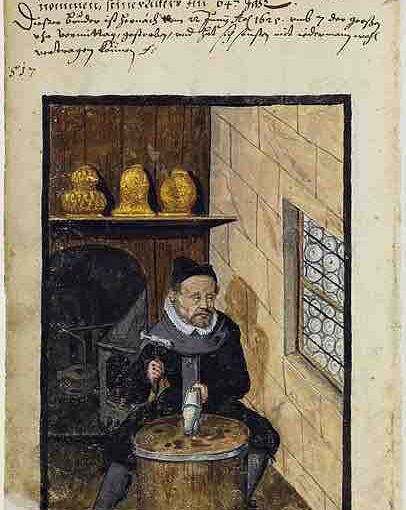1530 Rome, Italy Benvenuto Cellini cures himself of syphilis using the “guiac cure”
From his autobiography. Cellini (1500 – 1571). I have given the date of 1530 for the cure because a few pages previously, in another context, Cellini mentions that he was thirty years old:
The “guaiac cure” for syphilis was imported from the West Indies where syphilis was endemic and where the natives used this cure for it. See previous chapter on Colombus’s sailors bringing it to Europe. Guiac is a wood. A decoction was made from it to raise the temperature and the cure consisted of 2 sessions of hyperthermia per day for around 40 days. The hyperthermia was generated by drinking the guiac decoction, wrapping up in thick clothes and staying in bed for 2 hours in a hot room. The aim was to sweat as much as possible. In addition to this a near fast was observed. In the 20th century both syphilis and gonorhea have been cured with therapeutic hyperthermia. See my article on Monardes where I go into more detail.
Some time afterwards I sought to mend my shattered health, and with this view I betook myself to shooting when the winter came in. That amusement, however, led me to expose myself to wind and water, and to staying out in marsh-lands ; so that, after a few days, I fell a hundred times more ill than I had been before. I put myself once more under doctors’ orders, and attended to their directions, but grew always worse. When the fever fell upon me, I resolved on having recourse again to the wood ; but the doctors forbade it, saying that if I took it with the fever on me, I should not have a week to live. However, I made up my mind to disobey their orders, observed the same diet as I had formerly adopted, and after drinking the decoction four days, was wholly rid of fever. My health improved enormously ; and while I was following this cure, I went on always working at the models of the chalice. I may add that, during the time of that strict abstinence, I produced finer things and of more exquisite invention than at any other period of my life. After fifty days my health was re-established, and I continued with the utmost care to keep it and confirm it. When at last I ventured to relax my rigid diet, I found myself as wholly free from those infirmities as though I had been born again. Although I took pleasure in fortifying the health I so much longed for, yet I never left off working ; both the chalice and the Mint (Cellini was working for the pope) had certainly as much of my attention as was due to them and to myself”.
Several things are of interest here:
- Earlier on in his autobiography, during a time of plague in Florence, Cellini recounts how a friend brought a beautiful Bolognese prostitute of about 30 to stay for the night at Cellini’s house. Cellini tells how, although the prostitute was “very fine”, he instead, sneakily took her “very fair” servant girl of around 13 or 14 to bed. Cellini then tells us that at breakfast, he was seized with a “crushing headache”, several boils appeared on his left arm, together with a carbuncle on his left palm near to the wrist. A doctor treats Cellini immediately but Benvenuto does not tell us exactly what the doctor diagnosed or prescribed, only that the remedies worked. He tells us that the “sore was still open, with a plug of lint inside it and a plaster above, when I went out riding on a little wild pony” and then launches into another one of his improbable stories and there is no further mention of this affliction. Early symptoms of syphilis are quite mild and go away fairly quickly. Cellini does not tell us what he thought the affliction was. Did he think it was the first manifestations of the plague which were quickly nipped in the bud by the doctor’s remedies? Was this instead how Cellini caught syphilis in the first place?
- The guaiac cure involved drinking decoctions of guaic wood, staying in bed, fully clothed in a very warm room to induce sweating and a near fast for around 6 weeks. Although Cellini is fairly hazy on the details (these would have been well known to his contemporary readers – see entry on Monardes), it appears that he observed the conditions of the “cure” for two fifty five day periods using “the most scrupulous discipline and rules of abstinence that could be thought of”. Cellini has already told us, with thinly veiled sarcasm and cynicism, earlier in his autobiography, how Berengario had made a fortune treating dignitaries in Rome for the “French disease” with mercury and how ineffectual and dangerous Cellini thought this to be. So Cellini would have considered guaiac as the only option. No wonder he carried out the cure with the “most scrupulous discipline”.
- Cellini tells how he caught a fever, attributing this to his shooting forays on marshland. Fever is a possible symptom of (modern) secondary syphilis. So was this the syphilis returning, or was the fever caused by something else. In several studies (see entries) in the twentieth century, syphilis was cured by raising the body temperature to 40 degrees c for varying periods, using various heating methods, including innoculation with malaria. The guaiac wood concoction induced sweating, so in conjunction with a fever, might well have been effective in curing the syphilis.
4. Cellini tells us how healthy he feels after the “cures” and how he was able to do some of his best work. This kind of testimony is common to those who have carried out extended fasts.
 Copyright secured by Digiprove © 2021 Chris Parkinson
SUPPORT CHRIS
Copyright secured by Digiprove © 2021 Chris Parkinson
SUPPORT CHRIS 
